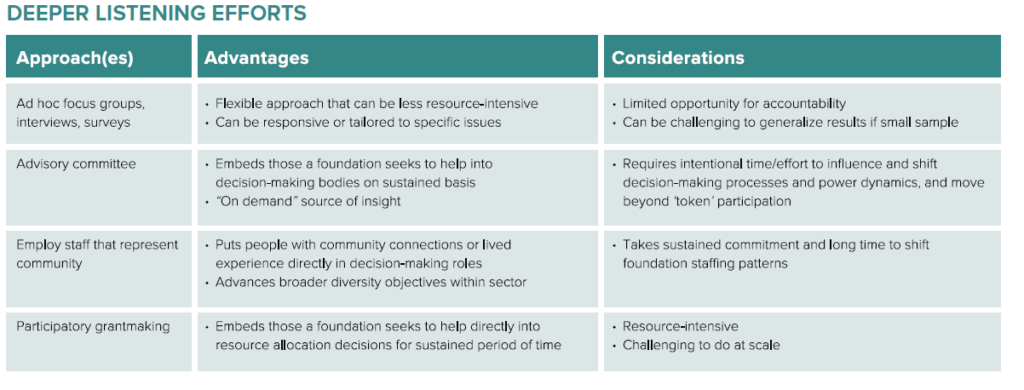Bridging The Gap: A Review of Foundation Listening Practices
This report defines foundation listening broadly, to mean funders’ efforts to consider the views, perspectives, and opinions of the communities and people they seek to help, and to use those insights to inform internal deliberations and decisions. Listening in this way can take lots of forms—including direct listening, such as focus or advisory groups, but also prospective community research that seeks to capture the sentiments of populations that foundations seek to help. It can also include indirect approaches where foundations benefit from the listening efforts led by others such as grantees.

While much has been written about how funders can pursue direct listening at the local scale, comparatively less has been written about how larger systems-level funders working across multiple geographies can approach this work in meaningful ways. Based on their research, the authors recommend the following as particularly promising and relevant practices.
- Advisory committees, if structured correctly, can be powerful mechanisms for staying grounded across initiatives, even at a systems level.
- The authors also recommend that foundations codify some kind of direct listening expectation as a required part of strategy origination/refresh through means such as listening tours or community research focused on its target population. This codification includes systematizing data collection but also developing processes for reflecting on what is learned.
- To the extent that foundations rely on grantees as its conduit for listening, foundations must also take steps to ensure that grantees are tapped
into the perspectives of the people they seek to help and are themselves employing high-quality feedback loops, and that the foundations have
intentional moments to learn from their insights.
Listening is fundamentally an invitation to take in new perspectives and ways of thinking; however, for it to be systematic, it must be
thought of as a set of muscles and structural reinforcements to be strengthened throughout an organization. Foundations, as institutions,
must create cultures that are supportive of input, structures for carrying out high-quality listening, and the means for holding people
accountable to these expectations. Moreover, internally, leadership must demonstrate an authentic interest in consuming and using this
new information.
